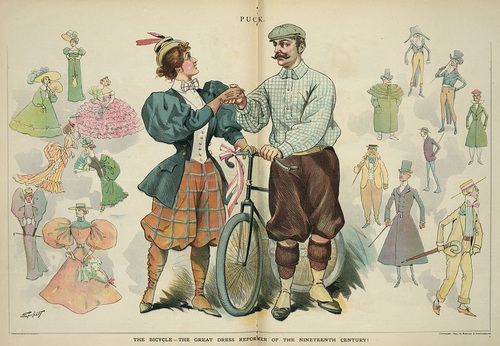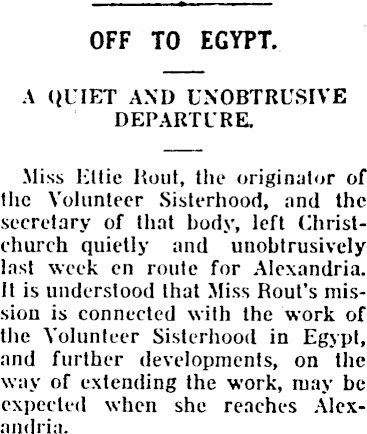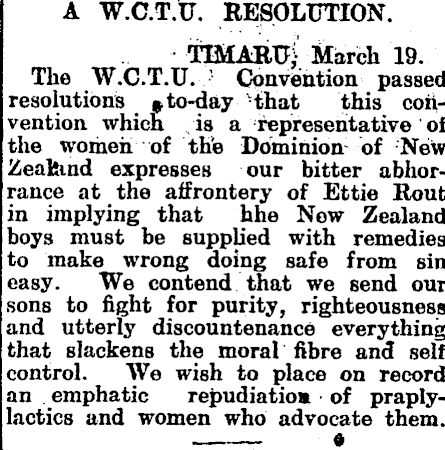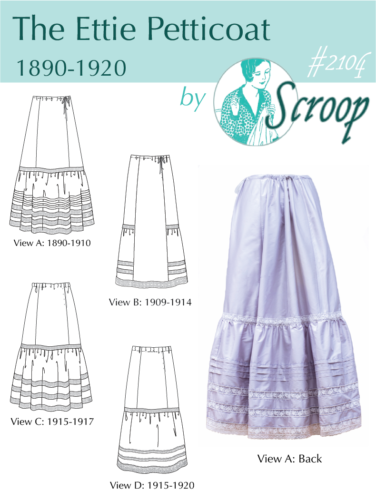The Ettie Petticoat didn’t get its name just because it makes for a cute hashtag (#ettiepettie), (although that did help!). It’s named for Ettie Rout: war hero, journalist and author, health campaigner, and the “wickedest woman in Britain”. She’s a fascinating figure whose modern legacy is as complicated as society’s reception of her was in her own time.
Ettie Rout was born in Tasmania in 1877. Her family moved to New Zealand in 1884, when she was almost 8. Her father worked as a plumber, and the family struggled financially.
Rout excelled at school, and later in shorthand and typing classes. In 1902 these skills landed her a position as a shorthand writer for the New Zealand Supreme Court (now the High Court). Here she was exposed to court cases covering a whole range of social issues: an unusual experience for an educated young woman at the dawn of the Edwardian era. In 1904 she became a journalist. She used her court experience to cover stories that went far beyond the fashion column and household tips articles that most women journalists were confined to.
Rout came of age at an amazing time. She was 16 when New Zealand women gained the vote. A variety of campaigns for social reform were linked the suffrage movement: worker’s rights, rational dress, temperance and prohibition, even health issues like diet and exercise.

The cycling costume & dress reform
Rout embraced many of these. She was an active socialist. She used her journalism skills to found and edit a newspaper for the New Zealand Shearers’ Union. She took up cycling and ‘physical culture’. She wrote impassioned letters about women’s rights to earn equal wages to men. She stopped wearing corsets (maybe – there’s contradictory evidence), and even wore trousers when she could get away with it. At some point she became a vegetarian. She became friends with the radical intellectuals of New Zealand, and was exposed to the newest in political, feminist, and sexual-health theories.

The Press, 13 June 1904
Not all of Rout’s convictions were so counter-culture for her time, or so acceptable in ours. She became a firm believer in eugenics: a doctrine that was wildly popular in the early 20th century (embraced by everyone from New Zealand’s Sir Truby King to Winston Churchill, to Theodore Roosevelt, to Henry Fairfield Osborn, the president of the American Museum of Natural History for a quarter of a century), but which is now, thankfully, well out of favour.
Also typical of her time, Rout also saw herself as a patriotic member of the British Empire. When WWI started she wanted to contribute to the war effort. To this end, Rout organised volunteer nurses to help out in the service camps in New Zealand, and later to go overseas.
Members of the VNS were between the ages of 30 & 50. The uniform of the Volunteer Nursing Sisterhood was:
“a blue print dress, blue lustre cloak, white panama hats, with white aprons and “Sister Dora” caps for indoor wear.”
You can see Ettie Rout and some VNS members here.
In 1916 Rout went to Egypt to serve with the VNS herself.

Ettie Rout’s Departure, The Sun (Christchurch), January 3rd, 1916
She quickly realised that there was one major gap in the soldier’s medical and social care that could not be addressed by serving tea at the YMCA and changing sheets at the hospitals. The overseas forces were rife with venereal disease.
If the Olympics have taught us anything it’s that if you put a lot of fit young people in one place, you’re going to need a lot of condoms. New Zealand and Australia has sent thousands of young men into a situation where they were free of their normal social constraints and the expectations of their community. They were alternately extremely bored and extremely terrified. They wanted something to do, realised they could die at any minute, and were in a country where they had significantly more money than the average women. They also, by and large, had very little sex education. VDs were the result.
Rout realised what scientific research has since backed up time and time again: education and prophylactics are much more effective at preventing STDs and unwanted pregnancy than moral strictures and draconian laws.
Rout began campaigning the New Zealand Medical Corp to issue prophylactic kits, and inspect brothels so they could recommend ‘hygenic’ ones.
When the NZMC ignored her, she took matters into her own hands. She assembled her own kit, set up a social club near the New Zealand Convalescent Hospital outside of London, and began selling the kit at the club. She continued to campaign for the kits to be official military issue, writing letters to New Zealand newspapers about the need for them. One of these letters so incensed the the Women’s Christian Temperance Union so much that they officially condemned Rout’s suggestion

Grey River Argus, 20 March 1918
Despite opposition in New Zealand, the letter had the desired effect. In 1917 the NZMC adopted Rout’s exact kit and made it compulsory issue for any solider going on leave. Not only did Rout get no credit or recognition, but the New Zealand government was so anxious to avoid any suggestion that their armed forces might be slack in moral fibre and self control that they forbid New Zealand papers from publishing Rout’s name, with a £100 fine for infractions.
Although the kits helped, Rout still felt that it was necessary to direct soldiers to clean brothels. So, just as she had with the kits, she decided she’d have to do it herself. She moved to Paris and began meeting trains of NZ soldiers, welcoming each soldier with a kiss on the cheek – and the business card of a safe brothel!
Rout continued her work until the end of the war, and then ran a Red Cross outpost as the war wound down. The NZ Returned Servicemen’s Association sent her a post-war tribute of £100 (how apropos!), but there was no official recognition of her service from New Zealand. Her own country may have snubbed her, but the French government awarded her the Médaille de la Reconnaissance française for her work inspecting brothels.
After the war Rout returned to writing, this time as an author. She published an exercise manual, a vegetarian cookbook, a wildly inaccurate book on Maori culture which was really just an excuse for her to promote eugenics (she claimed that Maori practiced eugenics by killing weak babies (did I mention wildly inaccurate?) – which was why they had been strong and healthy – not that eugenics should be practiced against them), and, most famously, 1923’s Safe Marriage: A Return to Sanity.
The latter was a best-seller in Britain and Australia, but banned in New Zealand. Its frank discussion on reproduction and sexual health so infuriated the Anglican church that one Bishop called her “the wickedest woman in Britain.”
Safe Marriage is an interesting read as an illustration of the information on reproduction and prophylactics that was available in the ‘teens and 20s. It also demonstrates the attitudes towards sexual responsibility and sexual health prevalent even among the most liberal elements of society. Or perhaps Ettie adapted the book to make it more palatable to a mainstream audience? (although church and medical responses suggest not).
Ettie Rout was married (to Mr Hornibrook, for those of you with extremely juvenile senses of humour) by this time, but the marriage didn’t last. She returned to New Zealand briefly in 1935-6, and then travelled on to Rarotonga, where she died of an overdose (probably intentionally).
Obituaries of Rout in New Zealand delicately skirted her work, referring to her as ‘humanitarian’ or as a campaigner for ‘welfare methods’

IN PARIS IN THE WAR YEARS.–Mrs. F. A. Hornibrook (Miss Ettie Rout), in Paris, where she conducted a hostel for colonial troops during the Great War, as well as inaugurating a campaign for welfare methods for the troops. Inset, Mrs. Hornibrook. who died at Rarotonga last Thursday.
It wasn’t until 1939 that any New Zealand newspaper actually addressed her work:

The Press, 6 December 1939, Letter to the Editor about Ettie Rout
Even then, the focused remained entirely on the men Ettie Rout helped. I’m also interested in all the woman that she helped, directly, and indirectly. How many thousands of women were not infected with VD’s spread by soldiers during and after the war because of her work?
Aesthetically, the Ettie Petticoat isn’t a clear match to its namesake. Rout preferred extremely practical ‘mannish’ dress, and a ruffly petticoat that is not. Instead, I was thinking of all those women who did wear ruffly petticoats, and were helped, whether they knew it or not, by Ettie. The link is also metaphorical: a petticoat pattern named for a woman who attempted to force her country to acknowledge and care for what went on under society’s skirts.


What a delightful read! Highly informative, practical, and with an excellent sense of humour. Thank you for recognising the oft-overlooked fallacy of historians and biographers to write on the subject at hand with a distinct reframing (or blatant ignoring) of topics or events deemed unpalatable to the contemporary reader.
A fascinating look into the namesake of your newest pattern (and one I really do need to purchase to improve my Fantail Skirt!).
Thank you! I’m so pleased you enjoyed it!
I think it’s really important to acknowledge that historical figures were rarely totally saints or utterly horrible. And they were always products of their times, so are going to hold opinions that are now completely dated.
There is so much history we are unaware of. What a well written, entertaining, and informative story! Thank you for sharing.
Fabulous and fascinating. I always say that the best stories are biographies. What a great film Ettie’s life would be! Thank you for sharing.
Thank you! Wouldn’t it just make a great film!
Fascinating! I have to admit I didn’t really understand why you named it after her until the final paragraph (lol) but it’s definitely a great way to share little known New Zealand history.
Wonderful–thank you so much for this very timely article. Here in the US, some very draconian laws regarding women’s sexual lives have been handed down in the most cowardly way. Sex, including sex work, should be both physically and emotionally safe. I love that she recognised the need to support safer sex about a century ago! And I just love the way that you write about it: forthrightedly, matter-of-factly, and without moralising.
The part about a safe marriage really struck me. It reminded me a bit of Gisella Perl, who performed safe abortions in WWII concentration camps, so that the women could one day have safe pregnancies and reproductive health in the future. Our Ettie made sure that returning men could also give their wives safe pregnancies and reproductive health. Fascinating!
Thank you for such a neat peek into the life of a really remarkable woman!
What a fantastic article! So much great information and history, and a great petticoat to boot. I’d modernize this by shortening the waist to knee portion and make a skirt out of it!
What a wonderful woman whose insights, humanity and compassion probably saved countless lives! And was ridiculed and condemned for her work! Ah such a shame, there should be stamps with her image, her story should be taught in schools! My ancestors also travelled from Tasmania to New Zealand and were suffragettes, involved with Women’s Vote and emancipation ~ surely they would have known each other! If only I could go back in time to meet these remarkable ladies! â€â™€ï¸